BOISE (Day 5 - part 5)
We walked back to the car and drove out to the Old Idaho Penitentiary.
The Idaho Territory was established in 1863. The first convicted men were held in a small, log jailhouse in Idaho City, where escapes occurred often. In 1867, Congress appropriated funds to construct a Territorial Prison. This location was chosen at the edge of these foothills due to the abundance of sandstone. The cornerstone was laid in 1870 (two full decades before statehood).
The first 11 men arrived here in 1872. A single three-story building contained 42 single-man cells. In 1877, a 12-foot surrounding fence was completed, allowing prisoners more time outside the cell house.
Built largely by the inmates, the complex grew to several buildings surrounded by a 17-foot wall. The prison closed in 1973, and the 416 inmates were moved to the new Idaho State Correctional Institution. During its 101 years of operation, the penitentiary received more than 13,000 inmates, with a maximum population of just over 600. 216 of them were women.

The sentences of the first 11 men ranged from 18 months to 15 years, though few of them served their full sentences.


(1) sally port, (2) administration building, (3) rose garden, (4) ice house, (5) solitary confinement, (6) hospital, (7) barber shop, (8) trusty dorm, (9) commissary, (10) dining hall, (11) original territorial prison, (12) new cell house, (13) #2 cell house, (14) #3 cell house, (15) basketball court, (16) #4 cell house, (17) #5 maximum security, (18) back gate, (19) shirt factory building, (20) laundry, (21) weapons exhibit


The sally port automobile gate was added in 1931 to help move goods and inmates in and out of the facility. All vehicles were locked within the gate and thoroughly searched before being allowed in or out.


This building was built in 1894 with 25 inch thick sandstone walls. It is now the administration building but was once the warden's office and even a library. The warden and his family used to live on the second level.


The old armory ... Large keys were used to lock the cell house doors.
We exited the administration building and found ourselves within the prison complex.


A walk/wait signal...

... and push-button buzzers set on poles controlled passage into the building.

The rose garden began as a vegetable garden by an inmate. Originally this was the site of six executions by hanging from 1900-1929.
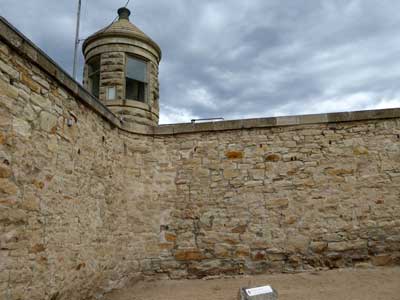

Guards monitored inmates from four stone towers. This is tower #4. From 1893-94, inmates quarried rock from the foothills to build the prison wall. This kept inmates "busy" but also cut labor costs. The wall doubled the side of the prison yard.



The ice house
Isolation areas consisted of two sections. One, built in 1923, was the Cooler. Each cell contained several men. The other, known as Siberia, was built in 1926. These were 12 solitary confinement cells, only 3 x 8 feet in size.
Siberia was used for unruly or dangerous inmates. Sentences varied from a day to several months depending on the infraction... slashing the throat of a guard held hostage during an escape attempt, fighting with a fellow inmate, or throwing the contents of one's night bucket on a guard. The inmate did not always know, going in, how much time he was going to have to do in here. There was no mail, visitors or reading (except the Bible). There was only a weekly shower, cell searches and two meal per day (sometimes only one).



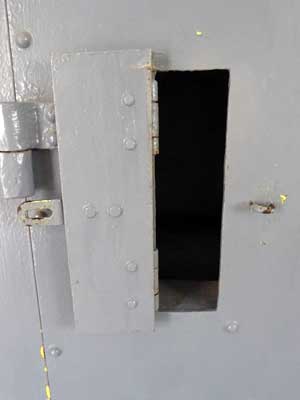
Meals were handed through the wicket door on a 3-inch-wide tray. This tiny door was also a main source of light... if it were left open. The only other light came though a vent hole in the ceiling.


The walls were sweaty in summer and icy in winter. For some, this resulted in suicide or insanity.


The Cooler was punishment cells that originally held up to 5 men in each of the 6 rooms. Eventually they switched to only one man per room.


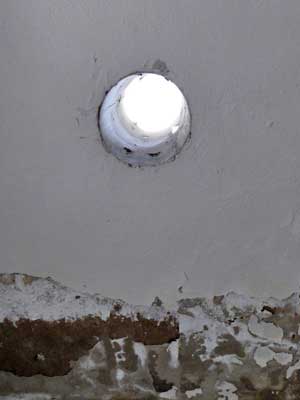

Ceiling vent hole ... cell door
Originally the blacksmith shop, this building (where there is now just a slab floor) was remodeled in 1912 and used as the prison hospital until the 1960s. It was then converted into the social services office but burned down in 1971 due to an electrical fire, which ignited a riot.
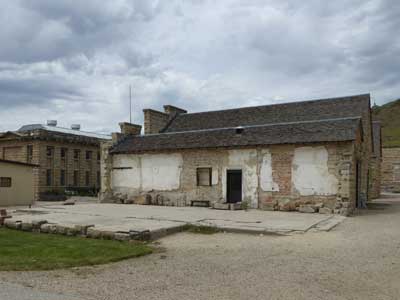
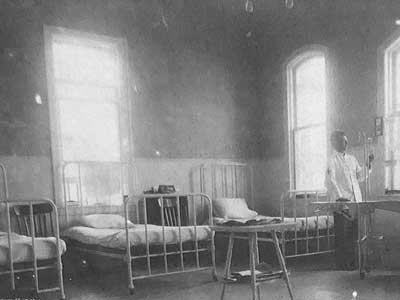
Completed in 1902, inmates received haircuts and shaves here, but it was closed in the 1950s to reduce the exchange of contraband.




This exhibit, in the form of comic book-style panels, looks at seven different disturbances and riots that occurred here. In each event, there are multiple sides of complicated issues, often stemming from misunderstandings and differences between the prisoners and those in charge.
1910: Exhausted from forced labor, 22 inmates were being marched nearly one mile from the prison quarry back to their cramped confinements. Six of them broke free and charged Warden John Snook's office. When they burst through the door, Snook had his revolver ready. They surrendered immediately but insisted they merely wanted to discuss the ill treatment, grueling working conditions, and spoiled food. Just 7 years previous, two inmates had died in an explosion at the quarry. They were sent to solitary.


(right) Warden Snook


1935: Dining hall rules required the men to eat all their food, no matter how unhappy they were with it. To express their displeasure, 5 inmates kicked over some tables and it turned into an all-out food fight. One guard, sitting in the 'bird's nest" above the inmates, shot down canisters of knockout gas. Another guard below raced for an open window to escape the gas. As he was halfway out, a cup of chocolate pudding hit him in the seat of his pants (leading to his nickname of Chocolate Slim). The inmates ran out the door but was quickly caught.


(right) There were strick rules in the dining hall... all facing one direction and no talking.


In 1952, 17 major riots occurred in prisons throughout the US. Reforms called for rehabilitation over punishment or 'custodial' treatment. This created tension between the guards and inmates. Here, the warden has suspended recreation in order to focus on construction projects. Desperate for activity, a few men took some scrap metal and created a pit to play horseshoes. They stopped but were allowed to create a 'grievance committee'. However, the prison 'heavies' (troublesome inmates) bullied the vote as to who should be on the committee, so the warden issued a new election of different men. He did indeed listen to them and agree to investigate, however, fearing a retaliation, he sent the four heavies to solitary. Enraged that the committee had not been first consulted, the prisoners rioted... breaking windows and setting the laundry on fire. After ordering the men back to their cells, he fired teargas. Wrapping their faces in wet towels and holding makeshift weapons, the prisoners burned down a construction scaffolding. Eventually they were all subdued and the grievance committee was abolished.

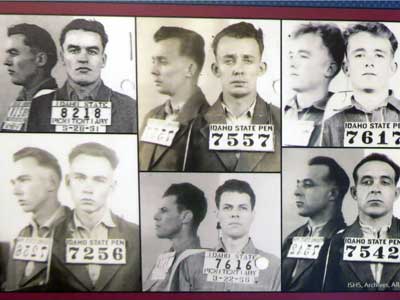
(right) Some of the heavies and rioters

A two-in-one way of taking a mugshot


1958: An inmate rushed into the captain's office and claimed there was a fight going on. However, when the captain and another guard arrived to break it up, they were ambushed by 6 armed inmates. The inmates managed to trick 7 more guards ("bulls"), holding them all hostage. In exchange for releasing the guards, the inmates insisted on speaking to journalists. It was done. When the journalists left, the men returned to their cells but the ringleaders were sent to solitary.




return • continue

